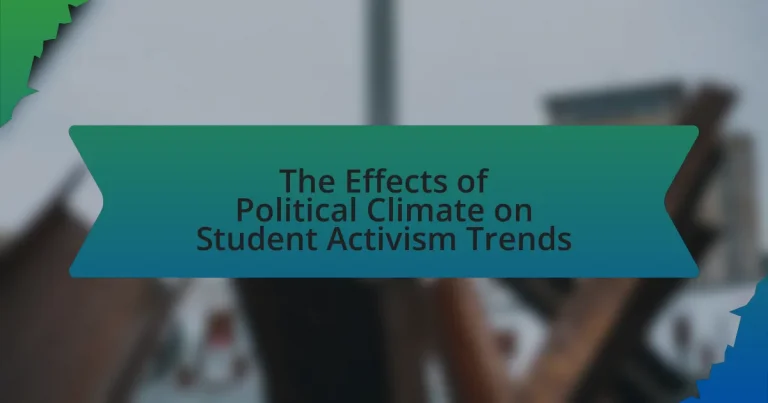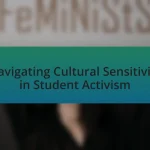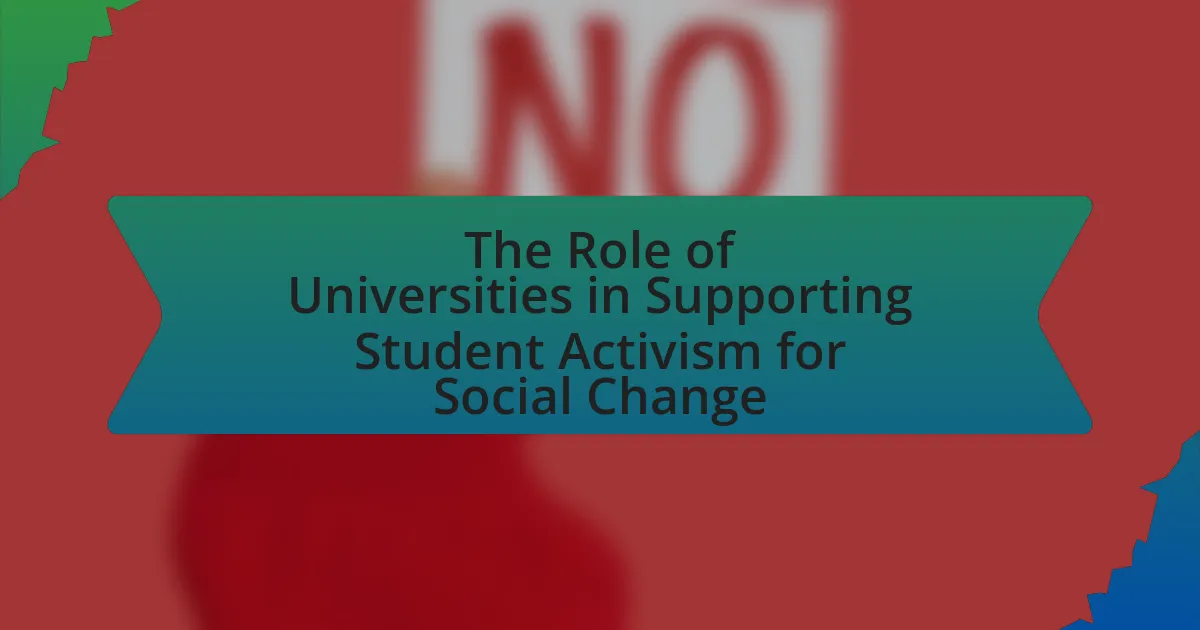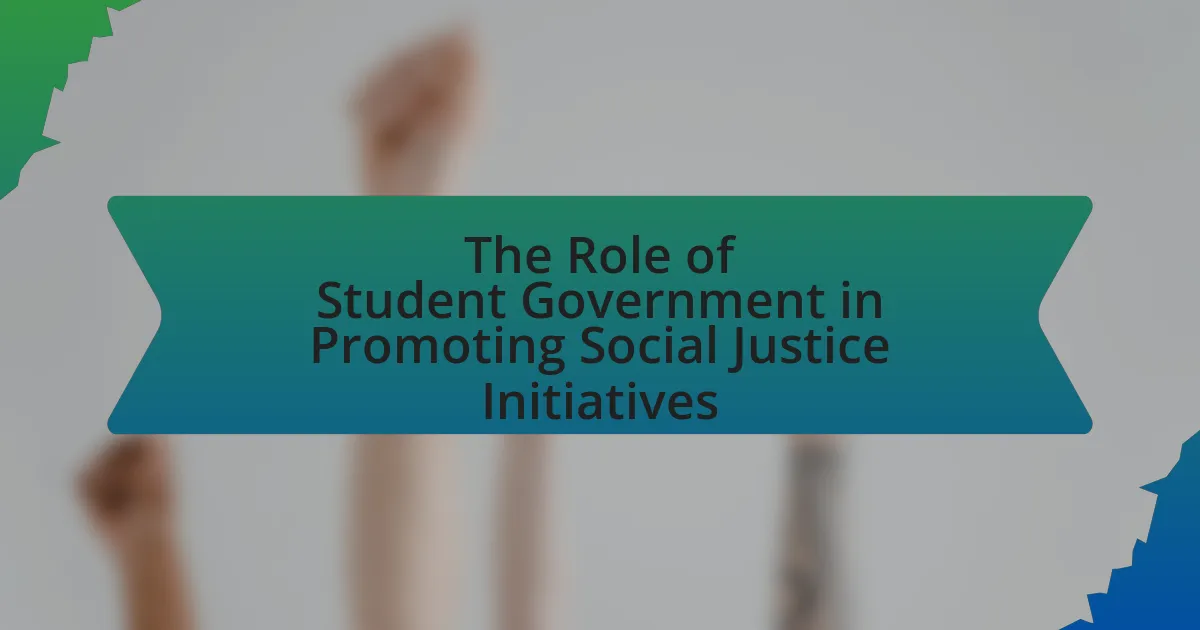The article examines the effects of political climate on student activism trends, highlighting how political environments shape the issues students prioritize and the methods they use for advocacy. It discusses historical contexts, such as the civil rights movement and recent protests like Black Lives Matter, illustrating the correlation between political conditions and student engagement. Key factors influencing activism include government policies, institutional support, and political awareness, while the article also explores prevalent issues among students today, such as climate change and social justice. Additionally, it addresses the challenges and strategies students face in varying political climates, emphasizing the importance of adaptability and resource utilization in their activism efforts.
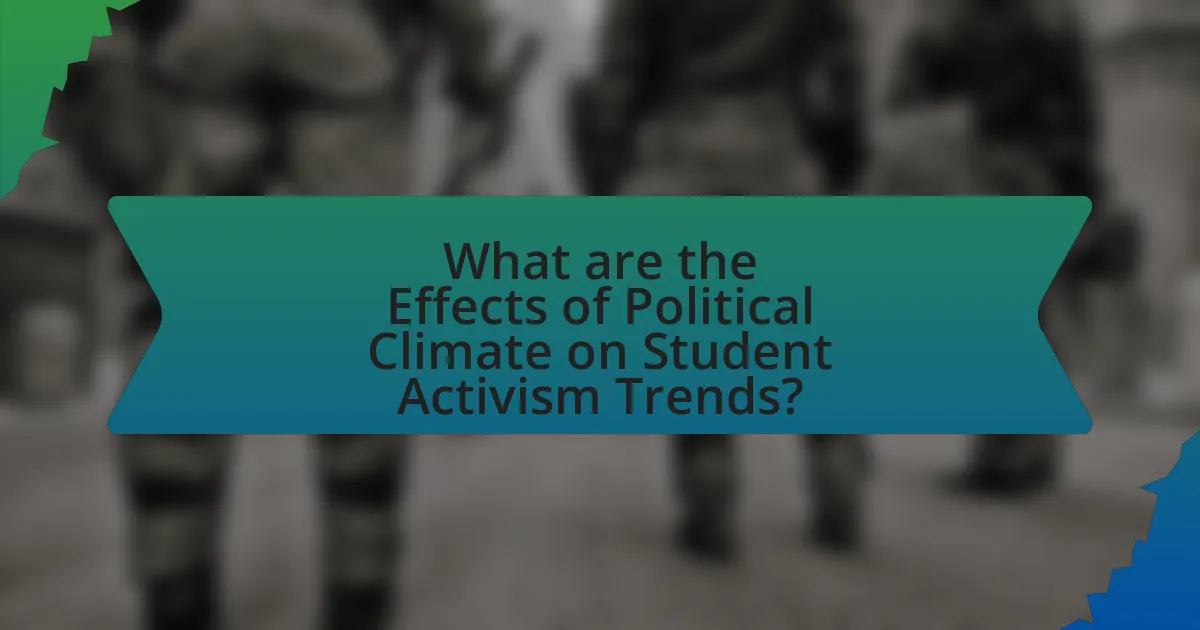
What are the Effects of Political Climate on Student Activism Trends?
The political climate significantly influences student activism trends by shaping the issues that students prioritize and the methods they use to advocate for change. For instance, during periods of heightened political tension, such as the civil rights movement in the 1960s or the anti-Vietnam War protests, student activism surged as young people mobilized around social justice and anti-war sentiments. Research indicates that when political leaders adopt controversial policies, student groups often respond with organized protests, campaigns, and social media activism to express dissent and push for reform. A study by the Higher Education Research Institute found that students are more likely to engage in activism when they perceive their political environment as oppressive or unjust, demonstrating a direct correlation between political climate and student engagement in activism.
How does the political climate influence student activism?
The political climate significantly influences student activism by shaping the issues that students prioritize and the methods they employ to advocate for change. In politically charged environments, students are more likely to mobilize around social justice, climate change, and human rights issues, as seen during the Black Lives Matter protests in 2020, where student-led initiatives gained momentum in response to systemic racism. Additionally, restrictive political climates can either suppress activism through censorship and repression or galvanize students to resist and organize against perceived injustices, as evidenced by the student protests in Iran in 2022, which were fueled by government oppression. Thus, the political context directly affects both the focus and intensity of student activism.
What specific political factors impact student engagement in activism?
Political factors that impact student engagement in activism include government policies, political climate, and institutional support. Government policies, such as those related to education funding and civil rights, can either encourage or suppress student activism. For instance, policies that promote inclusivity and social justice often galvanize students to engage in activism, as seen during movements like Black Lives Matter, where students mobilized in response to systemic racism. The political climate, characterized by the level of political polarization and public discourse, also influences student engagement; a highly polarized environment can either motivate students to advocate for change or lead to apathy due to disillusionment. Additionally, institutional support from universities, such as providing resources for organizing events or protecting students’ rights to protest, plays a crucial role in facilitating or hindering student activism. Research indicates that when institutions actively support political engagement, student participation in activism increases significantly.
How do changes in government policies affect student movements?
Changes in government policies significantly influence student movements by shaping the political and social environment in which students operate. For instance, when governments implement policies that restrict freedoms, such as limiting freedom of speech or assembly, students often mobilize to protest these restrictions, as seen during the Tiananmen Square protests in 1989 in China. Conversely, policies that promote educational access or social justice can galvanize student activism, encouraging students to advocate for further reforms, as demonstrated by the 2011 Occupy Wall Street movement, which was partly driven by students protesting economic inequality. These movements reflect students’ responses to perceived injustices or opportunities created by government actions, illustrating the direct correlation between policy changes and student activism.
Why is understanding the political climate important for student activism?
Understanding the political climate is crucial for student activism because it shapes the context in which students mobilize and advocate for change. The political environment influences the issues that are prioritized, the strategies that are effective, and the potential for success in achieving goals. For instance, during periods of political unrest or significant policy shifts, student movements often gain momentum, as seen in the 1960s civil rights movement, where students played a pivotal role in advocating for social justice. Additionally, awareness of the political landscape allows student activists to align their efforts with broader movements, enhancing their impact and fostering solidarity.
What role does political awareness play in shaping student activism?
Political awareness significantly influences student activism by informing students about social issues and motivating them to engage in collective action. When students possess a strong understanding of political dynamics, they are more likely to identify injustices and mobilize for change. For instance, research conducted by the Higher Education Research Institute found that students who are politically aware are more likely to participate in protests and advocacy efforts, demonstrating a direct correlation between awareness and activism levels. This awareness fosters critical thinking and encourages students to challenge the status quo, ultimately shaping the landscape of student activism.
How do historical political events influence current student activism trends?
Historical political events significantly shape current student activism trends by providing a framework of collective memory and established precedents for mobilization. For instance, the civil rights movement of the 1960s has inspired contemporary student-led initiatives advocating for racial equality and social justice, as seen in movements like Black Lives Matter. Additionally, events such as the Vietnam War protests have influenced student activism against military interventions and foreign policy decisions, leading to organized demonstrations on college campuses today. These historical contexts create a sense of urgency and legitimacy for current movements, as students draw parallels between past struggles and present issues, thereby fostering a culture of activism rooted in historical awareness.
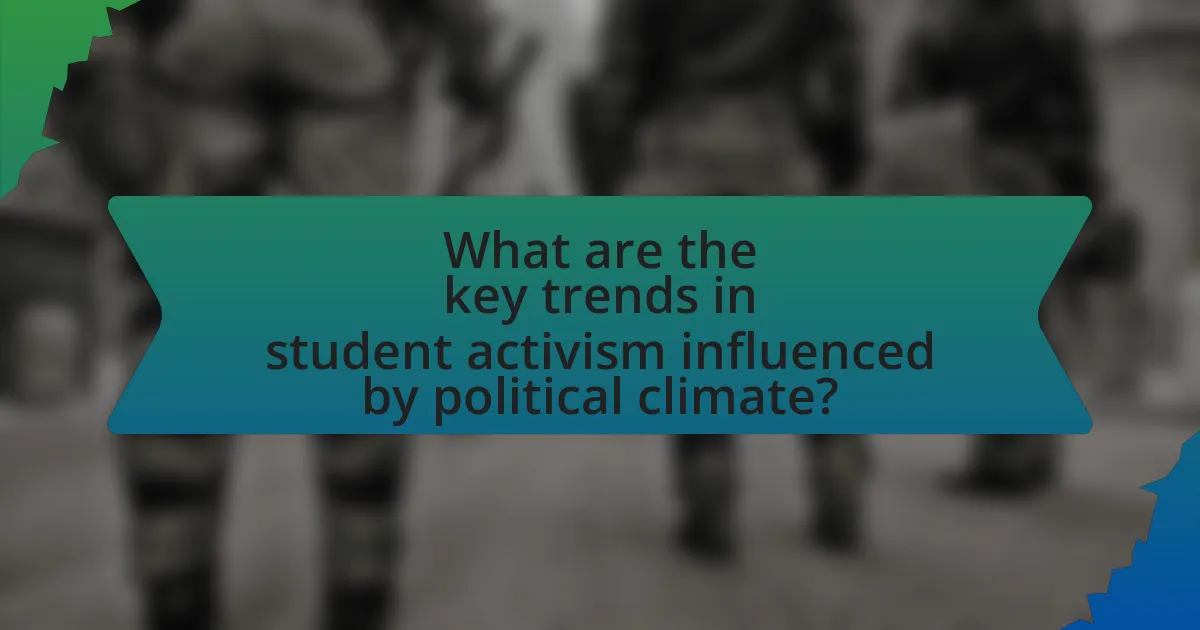
What are the key trends in student activism influenced by political climate?
Key trends in student activism influenced by political climate include increased mobilization around social justice issues, heightened engagement in electoral politics, and the use of digital platforms for organizing. In recent years, movements such as Black Lives Matter and climate strikes have seen significant participation from students, reflecting a growing awareness of systemic inequalities and environmental concerns. Additionally, the political climate has prompted students to advocate for policy changes, such as gun control and immigration reform, often leveraging social media to amplify their messages and coordinate actions. These trends demonstrate a shift towards intersectional activism, where students connect various social issues, driven by the urgency of the current political landscape.
What types of activism are most prevalent among students today?
Environmental activism is one of the most prevalent types of activism among students today. This trend is evidenced by the significant participation in movements such as Fridays for Future, which began in 2018 and has mobilized millions of students globally to advocate for climate action. Additionally, social justice activism, particularly focused on racial equality and gender rights, has gained momentum, especially following events like the Black Lives Matter protests in 2020. Surveys indicate that over 70% of students express a desire to engage in activism related to social issues, reflecting a strong commitment to advocacy in these areas.
How do social media platforms affect the visibility of student activism?
Social media platforms significantly enhance the visibility of student activism by providing a broad and immediate reach to diverse audiences. These platforms enable students to share their messages, organize events, and mobilize support quickly, often resulting in viral campaigns that attract media attention and public engagement. For instance, the #BlackLivesMatter movement gained substantial traction through social media, illustrating how online platforms can amplify student-led initiatives and influence public discourse. Research indicates that 79% of young activists believe social media is crucial for raising awareness about social issues, demonstrating its pivotal role in modern activism.
What issues are students most passionate about in the current political climate?
Students are most passionate about climate change, social justice, and mental health in the current political climate. Recent surveys indicate that 70% of students prioritize climate action, reflecting a growing concern over environmental policies and sustainability. Additionally, issues related to racial equality and rights have mobilized student activism, with organizations like Black Lives Matter and various advocacy groups gaining significant support on campuses. Mental health awareness has also surged, with 60% of students reporting that mental health resources are a critical issue for them, particularly in the context of the COVID-19 pandemic and its aftermath. These topics illustrate the intersection of personal well-being and broader societal challenges that resonate deeply with the student demographic today.
How do different political climates shape the methods of student activism?
Different political climates significantly influence the methods of student activism by dictating the level of freedom, safety, and resources available for organizing protests and campaigns. In authoritarian regimes, for example, student activism often relies on covert strategies, such as underground networks and digital anonymity, due to the risk of repression and punishment, as seen in countries like Iran during the 2009 Green Movement. Conversely, in democratic environments, students can utilize open forums, public demonstrations, and formal channels like petitions and lobbying, as evidenced by the widespread mobilization of students during the 2018 March for Our Lives in the United States, which effectively leveraged social media and public engagement. Thus, the political context directly shapes the tactics and strategies employed by student activists, reflecting their need to adapt to the prevailing conditions of their environment.
What strategies do students employ in response to oppressive political environments?
Students employ various strategies in response to oppressive political environments, including organizing protests, forming coalitions, and utilizing digital platforms for activism. These strategies enable students to mobilize support, raise awareness, and advocate for change despite restrictions. For instance, during the Arab Spring, students in countries like Tunisia and Egypt effectively used social media to coordinate protests and disseminate information, demonstrating the power of digital tools in oppressive contexts. Additionally, students often engage in grassroots organizing to build solidarity and create networks that can challenge authoritarian practices, as seen in movements like the 2019 Hong Kong protests. These approaches reflect a proactive stance against political repression, showcasing resilience and adaptability in the face of adversity.
How do students adapt their activism in more supportive political climates?
Students adapt their activism in more supportive political climates by shifting their focus from survival and resistance to collaboration and policy influence. In these environments, students often engage in constructive dialogue with policymakers, participate in formal advocacy efforts, and leverage their platforms to promote progressive agendas. For instance, research indicates that in supportive climates, student organizations are more likely to collaborate with local governments and institutions to implement initiatives that align with their goals, such as sustainability programs or social justice campaigns. This shift is evidenced by increased participation in campus governance and community outreach, demonstrating a proactive approach to activism rather than a defensive one.
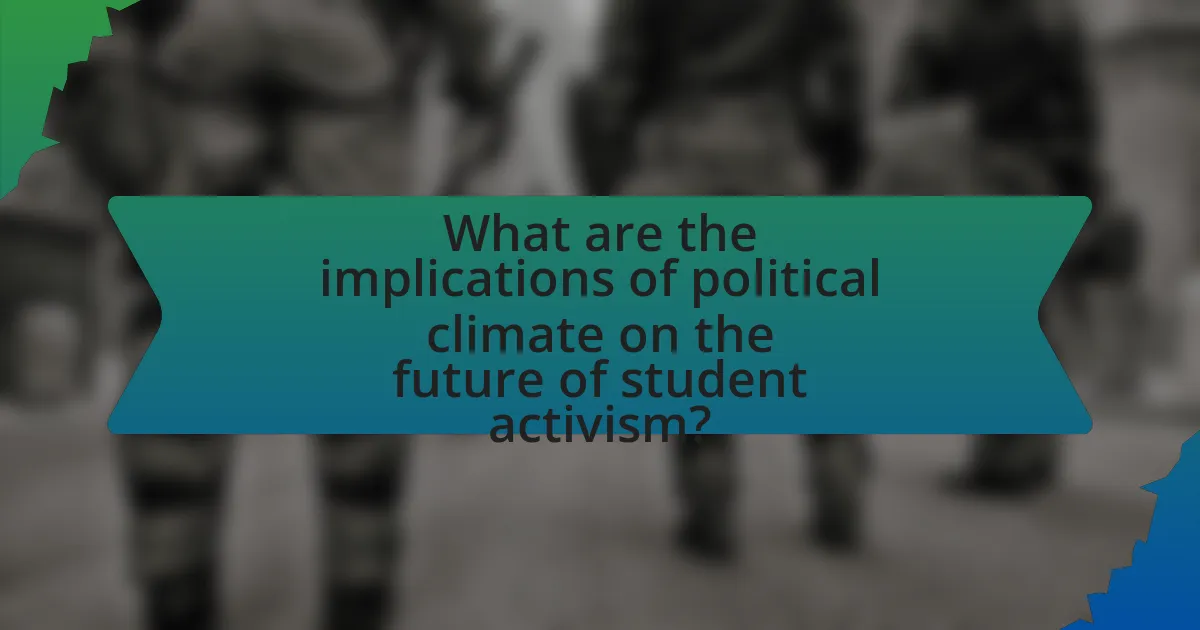
What are the implications of political climate on the future of student activism?
The political climate significantly influences the future of student activism by shaping the issues students prioritize and the methods they employ for advocacy. For instance, in politically repressive environments, students may resort to underground movements or digital activism to circumvent censorship, as seen in countries like Iran and Belarus, where student-led protests have emerged in response to authoritarian regimes. Conversely, in democratic settings, students often engage in organized protests and lobbying efforts, as evidenced by the March for Our Lives movement in the United States, which mobilized students to advocate for gun control following mass shootings. The political climate also affects the level of institutional support or opposition students encounter, impacting their ability to mobilize effectively. Thus, the implications of the political climate on student activism are profound, dictating both the strategies employed and the potential for achieving meaningful change.
How might future political changes affect student activism trends?
Future political changes are likely to significantly influence student activism trends by shaping the issues that students prioritize and the methods they employ for advocacy. For instance, shifts towards more progressive policies may galvanize students to mobilize around climate change and social justice, as seen in the rise of movements like Fridays for Future, which gained momentum in response to perceived governmental inaction on environmental issues. Conversely, regressive political changes could lead to increased activism against censorship and for civil rights, similar to the protests seen during the civil rights movement in the 1960s, where students played a crucial role in advocating for equality and justice. Historical patterns indicate that political climates directly impact the urgency and focus of student activism, as students often respond to perceived threats or opportunities within their sociopolitical environment.
What potential challenges could arise for student activists in changing political landscapes?
Student activists may face significant challenges in changing political landscapes, including repression from authorities, fragmentation of movements, and shifting public opinion. Repression can manifest as legal consequences, surveillance, or violence against activists, as seen in various countries where governments have cracked down on dissent. Fragmentation occurs when differing ideologies within the activist community lead to disunity, making it harder to present a cohesive front. Additionally, shifting public opinion can undermine support for student-led initiatives, particularly if the political climate turns hostile or if key issues lose relevance. These challenges can hinder the effectiveness and sustainability of student activism in dynamic political environments.
How can students prepare for shifts in political climate regarding activism?
Students can prepare for shifts in political climate regarding activism by staying informed about current events and understanding the historical context of political movements. Engaging in discussions, attending workshops, and participating in community forums can enhance their awareness and adaptability. Research indicates that students who actively engage with diverse perspectives are better equipped to navigate changing political landscapes, as seen in the increased activism during the 2016 U.S. presidential election, where students mobilized quickly in response to political shifts. By building networks with like-minded individuals and organizations, students can also create a support system that fosters resilience and strategic planning in activism efforts.
What best practices can enhance student activism in varying political climates?
Best practices that can enhance student activism in varying political climates include fostering inclusive dialogue, utilizing digital platforms for organization, and building coalitions with diverse groups. Inclusive dialogue encourages participation from all student demographics, ensuring that various perspectives are represented, which is crucial in politically charged environments. Utilizing digital platforms, such as social media, allows for rapid mobilization and information dissemination, as evidenced by movements like the Arab Spring, where online organizing played a pivotal role. Building coalitions with diverse groups strengthens the movement by pooling resources and amplifying voices, as seen in the success of the March for Our Lives campaign, which united students from different backgrounds to advocate for gun control. These practices collectively create a resilient framework for student activism, adaptable to different political climates.
How can students effectively mobilize support for their causes?
Students can effectively mobilize support for their causes by utilizing social media platforms to raise awareness and engage their peers. Research indicates that 79% of young people use social media, making it a powerful tool for outreach and organization. By creating compelling content, such as videos and infographics, students can communicate their message clearly and attract attention. Additionally, organizing events, such as rallies or informational sessions, can foster community involvement and encourage participation. Collaborating with established organizations can also lend credibility and expand reach, as these partnerships often provide resources and networks that enhance mobilization efforts.
What resources are available to assist students in their activism efforts?
Students can access various resources to assist in their activism efforts, including campus organizations, online platforms, and educational materials. Campus organizations, such as student government associations and activist clubs, provide networking opportunities, funding, and support for initiatives. Online platforms like social media and dedicated activism websites facilitate outreach and mobilization, allowing students to connect with broader movements. Educational materials, including workshops, webinars, and guides on effective activism strategies, equip students with the knowledge and skills necessary to advocate for their causes. These resources collectively enhance students’ ability to engage in activism effectively.
